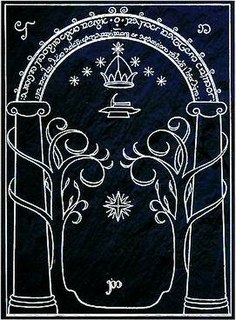 W
WMiddle-earth is the fictional setting of much of the English writer J. R. R. Tolkien's legendarium. The term is equivalent to the term Miðgarðr of Norse mythology, describing the human-inhabited world, that is, the central continent of the Earth in Tolkien's imagined mythological past. Tolkien's most widely read works, The Hobbit and The Lord of the Rings, are set entirely in Middle-earth; "Middle-earth" has also become a short-hand for the legendarium and Tolkien's fictional take on the world.
 W
WJ. R. R. Tolkien, a fantasy author and professional philologist, drew on the Old English poem Beowulf for multiple aspects of his Middle-earth legendarium, both in terms of elements such as names, monsters, and the structure of society in a heroic age, in terms of style such as creating an impression of depth and adopting an elegiac tone, and in terms of its larger but hidden symbolism.
 W
WEngland and Englishness appear in J. R. R. Tolkien's Middle-earth, more or less thinly disguised, in the form of the Shire and the lands close to it; in kindly characters such as Treebeard, Faramir, and Théoden; in its industrialised state as Isengard and Mordor; and as Anglo-Saxon England in Rohan. Lastly, and most pervasively, Englishness appears in the words and behaviour of the hobbits, both in The Hobbit and in The Lord of the Rings.
 W
WThe theme of environmentalism in The Lord of the Rings has been remarked by critics since the 1970s. The Hobbits' visions of Saruman's industrial hell of Isengard and Sauron's desolate polluted land of Mordor have been interpreted as comments on modern society, while the destruction of Isengard by the tree-giant Ents, and "The Scouring of the Shire" by the Hobbits, have a strong theme of restoration of the natural environment after such industrial pollution and degradation. However, Tolkien's love of trees and unspoilt nature is apparent throughout the novel.
 W
WJ. R. R. Tolkien invented quasi-heraldic devices for many of the characters and nations of Middle-earth. His descriptions were in simple English rather than in specific blazon. The emblems correspond in nature to their bearers, and their diversity contributes to the richly-detailed realism of his writings.
 W
WIn J. R. R. Tolkien's legendarium, the history of Arda, also called the history of Middle-earth, began when the Ainur entered Arda, following the creation events in the Ainulindalë and long ages of labour throughout Eä, the fictional universe. Time from that point was measured using Valian Years, though the subsequent history of Arda was divided into three time periods using different years, known as the Years of the Lamps, the Years of the Trees and the Years of the Sun. A separate, overlapping chronology divides the history into 'Ages of the Children of Ilúvatar'. The first such Age began with the Awakening of the Elves during the Years of the Trees and continued for the first six centuries of the Years of the Sun. All the subsequent Ages took place during the Years of the Sun. Most Middle-earth stories take place in the first three Ages of the Children of Ilúvatar.
 W
WJ. R. R. Tolkien's artwork was a key element of his creativity from the time when he began to write fiction. The philologist and author J. R. R. Tolkien prepared illustrations for his Middle-earth fantasy books, facsimile artefacts, more or less "picturesque" maps, calligraphy, and sketches and paintings from life. Some of his artworks combined several of these elements to support his fiction.
 W
WThe Lord of the Rings is an epic high fantasy novel by the English author and scholar J. R. R. Tolkien. Set in Middle-earth, the world at some distant time in the past, the story began as a sequel to Tolkien's 1937 children's book The Hobbit, but eventually developed into a much larger work. Written in stages between 1937 and 1949, The Lord of the Rings is one of the best-selling books ever written, with over 150 million copies sold.
 W
WThe Book of Lost Tales is a collection of early stories by English writer J. R. R. Tolkien, published as the first two volumes of Christopher Tolkien's 12-volume series The History of Middle-earth, in which he presents and analyses the manuscripts of those stories, which were the earliest form of the complex fictional myths that would eventually comprise The Silmarillion. Each of the Tales is followed by notes and a detailed commentary by Christopher Tolkien.
 W
WThe plants in Middle-earth, the fictional world devised by J. R. R. Tolkien, are a mixture of real plant species with fictional ones. Middle-earth was intended to represent the real world in an imagined past, and in many respects its natural history is realistic.
 W
WTolkien's maps, depicting his fictional Middle-earth and other places in his legendarium, helped him with plot development, guide the reader through his often complex stories, and contribute to the impression of depth in his writings.